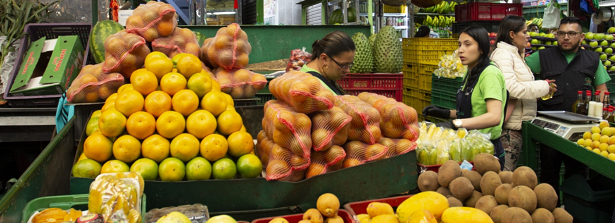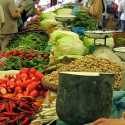Do the costs of the global food system outweigh its monetary value?

Food is essential for all living organisms to survive and flourish, but for human beings, food transcends biological needs and has long been an integral part of social life and culture. Over the past century, the food system has done very well in producing enough food to outpace population growth – reducing the real price of food to make it more accessible to the poor and drive down global hunger and poverty. While the remaining pockets of hunger require continued attention, the global food system is rapidly transforming, including in the less developed regions of Africa, Asia and parts of Latin America.
And yet, against this significant contribution to the global well-being, the global food system, as currently organized, is not fit for purpose. It imposes very high environmental and health costs ranging from greenhouse gas emissions, land degradation, water and air pollution, overdrawn aquifers, and biodiversity loss, to food borne diseases, growing anti-microbial resistance, persistent under- and malnourished children, and rising obesity.
So – what is the net verdict? Is the global food system adding or subtracting monetary value?
FAO estimates the gross value of global (primary) agricultural production at just over $5 trillion. The World Bank estimates (primary) agricultural value-added at about $3.2 trillion. The contribution of the food industry and food services sectors is difficult to estimate because of lack of reliable data , but we estimate that the food system generates 2 to 5 times as much value as farm production itself. We know for example that in the United States, for every $1 spent on food by the US consumer, a mere 11 cents are accounted by economic activity on farms while the rest accrues to numerous activities associated with transforming, delivering, or – increasingly- preparing the food Americans enjoy on a daily basis. The same is true in the United Kingdom where agriculture accounts for only 10 percent of the value of the food system. Since the post-farm to farm ratio of value in the food system is much lower in developing countries, we estimate the value of the global food system at roughly $8 trillion, or 10 percent of the $80 trillion global economy.
The calculation of costs is even less straightforward. Environmental and health costs are not reflected in the current market prices of the associated food commodities, and as such are difficult to assign a direct value. Nevertheless, it is worth approximating and exploring what these costs might be. Coming up with even some “back of the envelope” estimates could point to priority challenges and trigger important conversations around policy solutions.
We estimate that negative impacts associated with the way the current food system operates are at least $6 trillion, as shown in the table below. Note, however, that this is a conservative estimate, accounting only for five “externalities” of the current food system that existing studies have been put a value to – namely, malnutrition, food loss and waste, food safety, land degradation, and the greenhouse emissions from current agricultural (non-land related) practices. There are likely substantial costs associated with other “externalities” that have not yet been accounted for, some of which are also noted in the table below. The $6 trillion costs are equivalent to over 7 percent current global economic output each year – a bill that is simply too high for $8 trillion worth of food. Even more so, considering that this bill is incurred on top of the very large volume of public financial support to agricultural producers, estimated at nearly half a trillion US dollars on an annual basis.
| Food System Problem | Annual Economic Costs ($ trillions) |
| 2 billion people under- and malnourished (3 percent 2018 global GDP) | 2.43 |
| 2 billion people overweight and obese (2 percent of 2018 global GDP) | 1.62 |
| One third of agriculture production lost or wasted | 1.07 |
| Economic loss due to insufficient food safety | 0.11 |
| Economic loss due to land use and land cover change in terrestrial ecosystems (0.41 percent of 2018 global GDP) | 0.33 |
| 25 percent of land degraded due to poor management practices (0.25 percent of 2018 global GDP) | 0.20 |
| 13 percent global emissions from agriculture, other than from land use change (49.1 GT CO2 at $ 40/ton) | 0.27 |
| Costs still to be accounted for | |
| Biodiversity loss other than losses due to land use change (e.g., loss of pollination services, degraded wetlands, etc.) | |
| Health costs due to chemical and pesticide use, including from deteriorating water quality | |
| Contribution to rising anti-microbial resistance and associated costs | |
| Total costs | 6.03 |
Sources: Global Panel on Agriculture and Food Systems for Nutrition: “The Cost of Malnutrition.” Technical Brief No. 3, 2016; Jaffee, et al. 2018: “The Safe food Imperative.” The World Bank, Washington, DC; Nkonya, et al. 2016: “Global cost of Land Degradation.” In Economics of Land Degradation and Improvement, IFPRI, Washington, DC. FAOSTAT, FAO (accessed 2019) and World Development Indicators, World Bank (accessed 2019). Cost estimates for malnutrition are estimated using percent GDP lost calculated by FAO for 2010. These percentages are applied to 2018 global GDP data to arrive at reported economic costs. Similarly, land degradation costs use percentages calculated by Nkonya et al. (2016) for 2007 and apply them to 2018 global GDP estimates.
Note that the huge costs associated with biodiversity and ecosystem losses are not fully accounted for in the table above. The loss of pollination services which are essential for nearly 70 percent of global food production would be catastrophic. By some estimates, these costs would completely swamp the current global GDP.
The $6 trillion costs are equivalent to over 7 percent current global economic output each year – a bill that is simply too high for $8 trillion worth of food.
Martien Van Nieuwkoop
Director, Agriculture Global Practice at the World Bank
Who will pay? Everyone pays the public health costs of an increase in diet-related diseases through gradually increasing taxes. But the substantial costs due to environmental and natural resource damage will only be paid by future generations – as food production becomes much more difficult on a significantly eroded resource base and in a more hostile climate. The risk is that some of these costs will continue to rise exponentially, posing a significant threat to future ecological and hence economic stability.
Shocking numbers only matter if they can motivate action. Fortunately, technologies and practices already exist that can make agriculture and the broader food system more climate smart and environmentally friendly. In particular, we have the opportunity to realign the very large volume of public financial support to agricultural producers, estimated at nearly half a trillion US dollars on an annual basis, that creates distortions driving producers towards environmentally damaging practices and choices. If there is the political will, these resource transfers could be used more smartly to deliver public goods and services for healthier and more sustainable outcomes.
_ _ _
Source: World Bank, June 17, 2019






